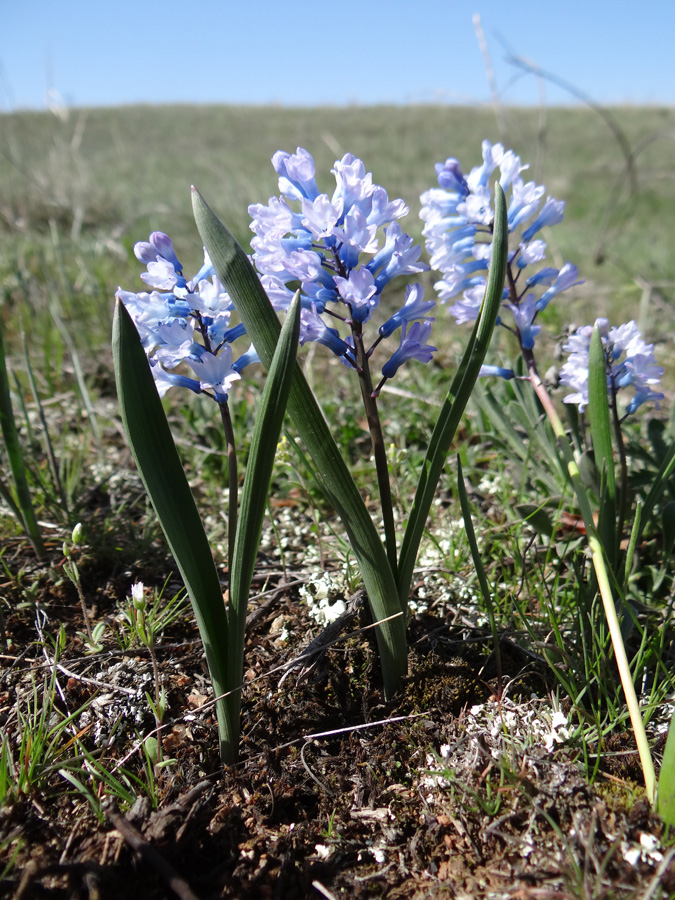Pallas's hyacinth
(Hyacinthella pallasiana)

Description
Hyacinthella pallasiana, commonly known as the Pallas's hyacinth, is a charming perennial plant species that belongs to the Asparagaceae family. Native to the eastern Mediterranean region, this stunning flower has captivated plant enthusiasts and gardeners with its unique characteristics and elegant appearance. In this article, we will delve into the world of Hyacinthella pallasiana, exploring its taxonomy, morphology, habitat, cultivation, and ecological significance. Taxonomy Hyacinthella pallasiana was first described by the renowned German botanist Peter Simon Pallas in 1808. It is part of the Hyacinthella genus, which includes several other species of bulbous plants. Within the family Asparagaceae, it is classified under the subfamily Scilloideae, known for its diverse range of plants, including hyacinths, squills, and grape hyacinths. Morphology Hyacinthella pallasiana boasts a remarkable display of delicate beauty. The plant features a single slender stem that emerges from an underground bulb. The stem can reach a height of up to 30 centimeters, bearing a dense raceme of bell-shaped flowers at its apex. The flowers are typically blue, ranging from pale to deep azure hues, with six distinct petals fused into a tube. Each petal forms a lobed structure, creating an exquisite star-like appearance. The leaves are long and narrow, emerging from the base of the plant in a tufted fashion. Habitat and Distribution The natural habitat of Hyacinthella pallasiana spans across the eastern Mediterranean, including countries such as Greece, Turkey, Cyprus, Lebanon, and Syria. Within this region, the plant thrives in various ecological niches, from rocky slopes and meadows to forest edges and open woodlands. It exhibits a preference for calcareous soils with good drainage. Its distribution is primarily influenced by factors such as soil composition, moisture levels, and temperature regimes. Cultivation Due to its aesthetic appeal, Hyacinthella pallasiana has gained popularity among gardeners and horticulturalists worldwide. Cultivating this species requires specific considerations to recreate its natural habitat successfully. Here are some guidelines for cultivating Pallas's hyacinth: Climate: Hyacinthella pallasiana favors a Mediterranean climate, characterized by mild, wet winters and hot, dry summers. It thrives in USDA hardiness zones 6-9. Soil: Well-drained, calcareous soils with a neutral to slightly alkaline pH are ideal for this species. A mix of sandy loam, gravel, and organic matter can enhance soil structure and drainage. Light requirements: Pallas's hyacinth prefers full sun to partial shade. However, in regions with scorching summers, providing some afternoon shade can prevent excessive heat stress. Planting: The bulbs of Hyacinthella pallasiana should be planted in autumn, around September to October. Place them at a depth of approximately 10-15 centimeters and space them around 10-15 centimeters apart. Watering: During the growing season, provide regular waterings to keep the soil slightly moist. However, ensure that the soil does not become waterlogged, as excessive moisture can cause bulb rot. Maintenance: Remove spent flowers to prevent seed production, as this may redirect the plant's energy away from bulb development. After the foliage dies back naturally, avoid cutting it off, as the leaves contribute to the bulb's nourishment. Ecological Significance Hyacinthella pallasiana holds ecological significance within its native range Ecological Significance: Hyacinthella pallasiana holds ecological significance within its native range, playing a vital role in the ecosystem as a nectar source for pollinators and a food source for certain herbivores. The bell-shaped flowers produce nectar, attracting a variety of insects, including bees, butterflies, and hoverflies. These insects aid in the plant's reproductive process by transferring pollen from one flower to another, promoting cross-pollination and genetic diversity. Furthermore, the plant serves as a host for the larvae of some butterfly species. Butterflies, such as the swallowtail butterfly (Papilio machaon), lay their eggs on the leaves of Hyacinthella pallasiana. The hatched larvae feed on the foliage, contributing to the plant's overall ecological interactions. Conservation Status and Threats Despite its ecological significance, Hyacinthella pallasiana faces several threats that have led to its decline and classification as a vulnerable species according to the IUCN Red List. Habitat loss, resulting from urbanization, agricultural expansion, and land development, poses a significant threat to the plant. Destruction of natural habitats disrupts the delicate balance required for its survival and restricts its distribution. Additionally, overcollection of wild specimens for horticultural purposes poses a threat to the species. Unregulated harvesting from the wild can deplete populations and negatively impact their genetic diversity. It is crucial to promote responsible and sustainable cultivation practices and encourage the use of propagated plants to reduce the pressure on wild populations. Conservation Efforts To safeguard the future of Hyacinthella pallasiana, conservation efforts are necessary. Several initiatives and strategies have been implemented to protect and preserve this species: Protected Areas: Establishing protected areas, such as national parks or nature reserves, can help conserve the natural habitats where Hyacinthella pallasiana occurs. These areas provide a safe haven for the plant and its associated ecosystem. Habitat Restoration: Restoration projects aimed at rehabilitating degraded habitats can contribute to the recovery of Hyacinthella pallasiana populations. These efforts involve reestablishing suitable growing conditions, reintroducing native plant species, and controlling invasive species. Cultivation and Propagation: Promoting the cultivation of Hyacinthella pallasiana in botanical gardens, nurseries, and private gardens can reduce pressure on wild populations. Using propagated plants and supporting ethical sourcing practices can ensure the long-term sustainability of the species in cultivation. Public Awareness and Education: Raising awareness about the importance of conserving native plant species like Hyacinthella pallasiana is crucial. Education programs, public campaigns, and community involvement can foster a sense of responsibility and encourage active participation in conservation efforts. Conclusion Hyacinthella pallasiana, with its enchanting beauty and ecological significance, is a plant species that deserves our attention and conservation efforts. By understanding its taxonomy, morphology, habitat, and cultivation requirements, we can work towards preserving this delicate beauty for future generations to admire. Through collective action and responsible practices, we can ensure that Hyacinthella pallasiana continues to grace our gardens and contribute to the rich biodiversity of the eastern Mediterranean region.
Taxonomic tree:







